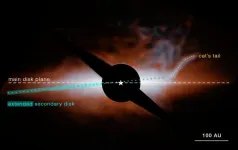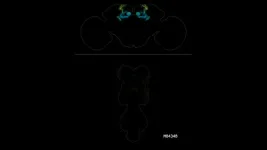(Press-News.org) Beta Pictoris, a young planetary system located just 63 light-years away, continues to intrigue scientists even after decades of in-depth study. It possesses the first dust disk imaged around another star — a disk of debris produced by collisions between asteroids, comets, and planetesimals. Observations from NASA’s Hubble Space Telescope revealed a second debris disk in this system, inclined with respect to the outer disk, which was seen first. Now, a team of astronomers using NASA’s James Webb Space Telescope to image the Beta Pictoris system (Beta Pic) has discovered a new, previously unseen structure.
The team, led by Isabel Rebollido of the Astrobiology Center in Spain, used Webb’s NIRCam (Near-Infrared Camera) and MIRI (Mid-Infrared Instrument) to investigate the composition of Beta Pic’s previously detected main and secondary debris disks. The results exceeded their expectations, revealing a sharply inclined branch of dust, shaped like a cat’s tail, that extends from the southwest portion of the secondary debris disk.
“Beta Pictoris is the debris disk that has it all: It has a really bright, close star that we can study very well, and a complex cirumstellar environment with a multi-component disk, exocomets, and two imaged exoplanets,” said Rebollido, lead author of the study. “While there have been previous observations from the ground in this wavelength range, they did not have the sensitivity and the spatial resolution that we now have with Webb, so they didn’t detect this feature.”
A Star’s Portrait Improved with Webb
Even with Webb or JWST, peering at Beta Pic in the right wavelength range — in this case, the mid-infrared — was crucial to detect the cat’s tail, as it only appeared in the MIRI data. Webb’s mid-infrared data also revealed differences in temperature between Beta Pic’s two disks, which likely is due to differences in composition.
“We didn’t expect Webb to reveal that there are two different types of material around Beta Pic, but MIRI clearly showed us that the material of the secondary disk and cat’s tail is hotter than the main disk,” said Christopher Stark, a co-author of the study at NASA’s Goddard Space Flight Center in Greenbelt, Maryland. “The dust that forms that disk and tail must be very dark, so we don’t easily see it at visible wavelengths — but in the mid-infrared, it’s glowing.”
To explain the hotter temperature, the team deduced that the dust may be highly porous “organic refractory material,” similar to the matter found on the surfaces of comets and asteroids in our solar system. For example, a preliminary analysis of material sampled from asteroid Bennu by NASA’s OSIRIS-REx mission found it to be very dark and carbon-rich, much like what MIRI detected at Beta Pic.
The Tail’s Puzzling Beginning Warrants Future Research
However, a major lingering question remains: What could explain the shape of the cat’s tail, a uniquely curved feature unlike what is seen in disks around other stars?
Rebollido and the team modeled various scenarios in an attempt to emulate the cat’s tail and unravel its origins. Though further research and testing is required, the team presents a strong hypothesis that the cat’s tail is the result of a dust production event that occurred a mere one hundred years ago.
“Something happens — like a collision — and a lot of dust is produced,” shared Marshall Perrin, a co-author of the study at the Space Telescope Science Institute in Baltimore, Maryland. “At first, the dust goes in the same orbital direction as its source, but then it also starts to spread out. The light from the star pushes the smallest, fluffiest dust particles away from the star faster, while the bigger grains do not move as much, creating a long tendril of dust.”
“The cat’s tail feature is highly unusual, and reproducing the curvature with a dynamical model was difficult,” explained Stark. “Our model requires dust that can be pushed out of the system extremely rapidly, which again suggests it’s made of organic refractory material.”
The team’s preferred model explains the sharp angle of the tail away from the disk as a simple optical illusion. Our perspective combined with the curved shape of the tail creates the observed angle of the tail, while in fact, the arc of material is only departing from the disk at a five-degree incline. Taking into consideration the tail’s brightness, the team estimates the amount of dust within the cat’s tail to be equivalent to a large main belt asteroid spread out across 10 billion miles.
A recent dust production event within Beta Pic’s debris disks could also explain a newly-seen asymmetric extension of the inclined inner disk, as shown in the MIRI data and seen only on the side opposite of the tail. Recent collisional dust production could also account for a feature previously spotted by the Atacama Large Millimeter/submillimeter Array in 2014: a clump of carbon monoxide (CO) located near the cat’s tail. Since the star’s radiation should break down CO within roughly one hundred years, this still-present concentration of gas could be lingering evidence of the same event.
“Our research suggests that Beta Pic may be even more active and chaotic than we had previously thought,” said Stark. “JWST continues to surprise us, even when looking at the most well-studied objects. We have a completely new window into these planetary systems.”
These results were presented in a press conference at the 243rd meeting of the American Astronomical Society in New Orleans, Louisiana.
The observations were taken as part of Guaranteed Time Observation program 1411.
The James Webb Space Telescope is the world’s premier space science observatory. Webb is solving mysteries in our solar system, looking beyond to distant worlds around other stars, and probing the mysterious structures and origins of our universe and our place in it. Webb is an international program led by NASA with its partners, ESA (European Space Agency) and the Canadian Space Agency
END
NASA’s Webb discovers dusty ‘cat’s tail’ in Beta Pictoris System
2024-01-10
ELSE PRESS RELEASES FROM THIS DATE:
Texas A&M AgriLife Research gets $5.2 million grant for onion improvement
2024-01-10
Texas A&M AgriLife Research received more than $5.2 million in grant funding from the U.S. Department of Agriculture’s National Institute of Food and Agriculture for a project to address multiple aspects of the southern U.S. onion harvest system.
Subas Malla, Ph.D., Texas A&M AgriLife Research associate professor at the Texas A&M AgriLife Research and Extension Center in Uvalde, will serve as director for a short-day onion project. (Texas A&M AgriLife photo by Paul Schattenberg)
The director for the “Ensuring Future Economic Viability of U.S. Short-Day ...
Preeclampsia and preterm birth risk may be reduced by calcium dose lower than current WHO standard
2024-01-10
Key points:
According to two trials of 11,000 pregnant women in India and in Tanzania, low-dose calcium supplementation (500 milligrams per day) appears as effective at reducing the risk of preeclampsia and preterm birth as high-dose calcium supplementation (1,500 milligrams per day).
The World Health Organization currently recommends high-dose calcium supplementation—equivalent to three calcium pills a day—for pregnant women in contexts with low-calcium diets, predominantly low- and middle-income countries. Lowering the pill burden to one 500mg ...
MSU-led study: Majority of US hospitals found COVID-19 reporting directives to be inconsistent
2024-01-10
EAST LANSING, Mich. – The U.S. health care response during the early stages of the COVID-19 pandemic unveiled challenges in public health reporting systems and electronic clinical data exchange.
A new study led by John (Xuefeng) Jiang, Eli Broad Endowed Professor of Accounting in MSU’s Broad College of Business, examines U.S. hospitals’ experiences in public health reporting, accessing clinical data from external providers for COVID-19 patient care, and their success in reporting vaccine-related ...
Janelia shares ‘greatest hits’ of tools to study the fly brain
2024-01-10
The holidays may be over, but neuroscientists are getting a special gift to kick off the new year: access to a greatest hits collection from one of Janelia’s longest running and successful Project Teams.
Janelia’s FlyLight Project Team, which has worked for more than a decade to create tools to study the fly brain, is making a core collection of their best genetically engineered fly strains available to researchers worldwide through the Bloomington Drosophila Stock Center. The brain images of these flies, along with hundreds of thousands of images from thousands of additional fly lines, are also now freely accessible through Janelia websites.
These ...
Integrating dimensions to get more out of Moore’s Law and advance electronics
2024-01-10
UNIVERSITY PARK, Pa. — Moore's Law, a fundamental scaling principle for electronic devices, forecasts that the number of transistors on a chip will double every two years, ensuring more computing power — but a limit exists.
Today's most advanced chips house nearly 50 billion transistors within a space no larger than your thumbnail. The task of cramming even more transistors into that confined area has become more and more difficult, according to Penn State researchers.
In a study ...
Need for speed: How hummingbirds switch mental gears in flight
2024-01-10
Hummingbirds use two distinct sensory strategies to control their flight, depending on whether they’re hovering or in forward motion, according to new research by University of British Columbia (UBC) zoologists.
“When in forward fight, hummingbirds rely on what we call an ‘internal forward model’—almost an ingrained, intuitive autopilot—to gauge speed,” says Dr. Vikram B. Baliga, lead author of a new study on hummingbird locomotion published in Proceedings of the Royal Society B. ...
Wristband monitors provide detailed account of air pollution exposure
2024-01-10
Environmental epidemiologists at Columbia University Mailman School of Public Health, in collaboration with an interdisciplinary team of researchers at Oregon State University, Pacific Northwest National Labs, and Mt. Sinai School of Medicine, report on the findings of a new study of air pollution exposures collected using personal wristband monitors worn by pregnant individuals in New York City matched with data from a questionnaire. Factors predictive of exposures to air pollution include income, time spent outdoors, maternal age, country of birth, transportation type, and season.
The researchers examined an unprecedented number ...
Scaling up urban agriculture: Research team outlines roadmap
2024-01-10
URBANA, Ill. — Urban agriculture has the potential to decentralize food supplies, provide environmental benefits like wildlife habitat, and mitigate environmental footprints, but researchers have identified knowledge gaps regarding both the benefits and risks of urban agriculture and the social processes of growing more food in urban areas.
In a new paper published in Nature Food, an interdisciplinary group of experts, including a researcher from the University of Illinois Urbana-Champaign, survey ...
Black people face strokes at higher rates, younger ages than white people
2024-01-10
EMBARGOED FOR RELEASE UNTIL 4 P.M. ET, WEDNESDAY, JANUARY 10, 2024
MINNEAPOLIS – Black people consistently had a higher rate of stroke than white people over a recent 22-year period, according to a study published in the January 10, 2024, online issue of Neurology®, the medical journal of the American Academy of Neurology. The study also found that the average age of Black people experiencing stroke was nearly 10 years younger than that of white people, another inequity that grew over time.
“We found that the rate of stroke is decreasing over time in both Black and white people—a very encouraging trend for U.S. prevention efforts,” said study ...
ASBMB announces 2024 class of fellows
2024-01-10
The American Society for Biochemistry and Molecular Biology today announced its 2024 class of fellows. The honorific program recognizes scientists who have made outstanding contributions to the field through their research, teaching, mentoring or other forms of service.
Edward Eisenstein, an associate professor of bioengineering at the University of Maryland and ASBMB Membership Committee chair, and Judith Bond, an adjunct professor of biochemistry and biophysics at the University of North Carolina at Chapel Hill and ...





